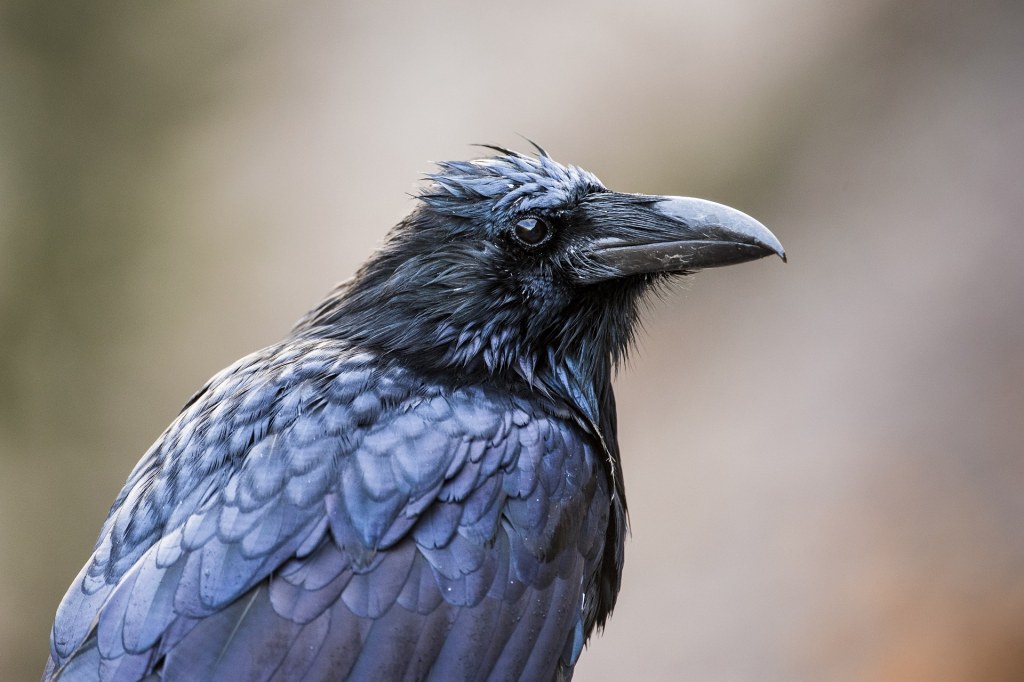The Enchanting Blue Raven Bird: Uncover Its Fascinating World And Take Flight With Us!
Blue Raven Bird: A Fascinating Creature of the Skies
Introduction
Dear Raven Enthusiast,
2 Picture Gallery: The Enchanting Blue Raven Bird: Uncover Its Fascinating World And Take Flight With Us!


Welcome to the world of the magnificent blue raven bird! In this article, we will delve into the captivating features and intriguing behaviors of this avian wonder. As a fellow bird lover, I am thrilled to share with you the wonders of the blue raven bird and provide you with valuable insights. So, let’s embark on this journey together and discover the secrets of this extraordinary creature.
Overview of Blue Raven Bird

Image Source: rare-gallery.com
The blue raven bird, scientifically known as Corvus corax azureus, is a rare and majestic species that captivates both bird enthusiasts and researchers alike. With its unique blue plumage, the blue raven stands out among its black-feathered relatives. This stunning coloration is caused by a genetic mutation that affects the production of melanin, resulting in a striking blue hue.
The blue raven bird is native to the remote mountainous regions of North America. It thrives in dense forests, where it can find ample food sources and build its nests. Known for their intelligence and adaptability, blue ravens have successfully adapted to various habitats, including urban areas.

Image Source: www.hww.ca
Now, let’s dive into the fascinating details about this extraordinary creature.
What Makes the Blue Raven Bird Unique?
🔹 Incredible Blue Plumage: The blue raven bird’s most distinctive feature is its mesmerizing blue plumage. This rare coloration sets it apart from other members of the raven family and makes it a sight to behold.
🔹 Intelligent and Curious Nature: Blue ravens are highly intelligent birds, capable of problem-solving and complex communication. Their curiosity often leads them to explore their surroundings and learn from their experiences.
🔹 Varied Vocalizations: Blue raven birds have an extensive repertoire of calls, ranging from deep croaks to melodic songs. These vocalizations serve various purposes, including communication within their social groups and defending their territory.
🔹 Social Behavior: Blue ravens are highly sociable creatures, living in small groups called congregations. Within these groups, they engage in cooperative hunting, nest building, and even play. Their strong social bonds contribute to their overall survival and success as a species.
🔹 Ecological Importance: Despite their dark reputation in folklore, blue ravens play a vital role in maintaining ecosystem balance. They are scavengers and predators, feeding on carrion and controlling populations of small mammals and insects.
Now that we understand what sets the blue raven bird apart, let’s explore more about its origins and presence in the natural world.
Who Are the Blue Raven Birds?
The blue raven bird, a rare subspecies of the common raven, showcases distinctive characteristics that differentiate it from its relatives. It is important to note that the blue plumage is not present in all blue ravens, making it a truly unique and special sight to behold.
Blue ravens are known for their highly adaptable nature, thriving in a variety of habitats. From dense forests to urban environments, these birds have managed to establish a presence and continue to captivate observers with their beauty and intelligence.
Despite their scarcity, blue raven birds have managed to maintain stable populations in their natural habitats. Conservation efforts are crucial to ensure their continued existence and protection.
As we delve deeper into the world of blue ravens, let’s discover when and where you can spot these remarkable creatures.
When and Where to Find Blue Raven Birds?
Blue raven birds can primarily be found in the remote mountainous regions of North America. Their natural habitats include dense forests, where they can find ample food sources, nesting sites, and protection.
While the sightings of blue ravens are rare, they occur throughout the year, making it possible for determined birdwatchers to catch a glimpse of these fascinating creatures. However, it’s essential to respect their natural habitats and observe them from a distance, allowing them to thrive undisturbed.
Now that we know where and when to find blue raven birds, let’s explore the reasons behind their unique blue coloration.
Why Are Blue Raven Birds Blue?
The mesmerizing blue coloration of the blue raven bird is the result of a genetic mutation affecting the production of melanin, the pigment responsible for feather color. This mutation leads to a reduction in melanin production, resulting in the striking blue hue that distinguishes them from their black-feathered relatives.
While the exact genetic mechanism behind the blue plumage is still being studied, researchers believe that it might be an adaptive trait that offers camouflage or a signal of genetic fitness to potential mates.
Now that we understand the reasons behind their unique coloration, let’s uncover how blue ravens have managed to thrive in their diverse habitats.
How Do Blue Raven Birds Adapt to Their Environment?
Blue raven birds possess exceptional adaptability, allowing them to thrive in various environments. Some of the key adaptations that contribute to their survival include:
🔸 Versatile Diet: Blue ravens are opportunistic omnivores, meaning they can consume a wide range of foods. Their diet includes fruits, seeds, insects, small mammals, and carrion. This adaptability enables them to find sustenance in diverse habitats.
🔸 Nesting Habits: Blue ravens build their nests in tall trees, strategically selecting locations that provide protection from predators and ensure the survival of their offspring. Their nesting habits contribute to the successful reproduction and population growth of the species.
🔸 Social Cohesion: Living in small groups called congregations allows blue ravens to benefit from cooperative hunting, nest defense, and sharing of valuable resources. Their social bonds contribute to their overall success in adapting to their environment.
As we uncover the remarkable adaptations of blue raven birds, let’s take a closer look at the advantages and disadvantages of their unique characteristics.
Advantages and Disadvantages of Blue Raven Birds
Advantages:
1️⃣ Pest Control: Blue ravens play a crucial role in controlling populations of small mammals and insects, which can have a positive impact on agricultural areas and human settlements.
2️⃣ Scavengers: Their scavenging behavior helps to maintain ecosystem balance by cleaning up carrion, preventing the spread of diseases and unpleasant odors.
3️⃣ Intelligent Hunters: Blue ravens’ problem-solving abilities and cooperative hunting strategies make them efficient predators, contributing to the overall balance of prey populations.
Disadvantages:
1️⃣ Nest Predation: The presence of predators poses a threat to blue raven nests and their offspring, leading to potential population declines in certain areas.
2️⃣ Competition for Resources: Blue ravens may face competition from other scavengers and predators, resulting in potential conflicts and reduced access to food sources.
3️⃣ Human-Induced Threats: Urban development and habitat destruction pose significant challenges to the survival of blue raven birds, as their natural habitats diminish.
Now, let’s address some frequently asked questions to further enhance our understanding of blue raven birds.
Frequently Asked Questions (FAQ)
1. Are blue raven birds considered endangered?
No, blue raven birds are not considered endangered. Though rare, they have managed to maintain stable populations in their natural habitats. However, their conservation status should be closely monitored due to habitat loss and other human-induced threats.
2. Can blue ravens mimic human speech?
No, blue ravens cannot mimic human speech like some other species of birds. Their vocalizations primarily consist of a wide range of calls and songs that serve various communication purposes within their social groups.
3. Are blue ravens monogamous?
Yes, blue ravens are monogamous birds. They form long-term pair bonds and engage in cooperative behaviors, such as nest building and raising their offspring together.
4. How do blue ravens communicate?
Blue ravens communicate through a combination of vocalizations, body language, and visual displays. Their diverse repertoire of calls and songs allows them to convey complex messages to their group members.
5. Can blue raven birds be kept as pets?
No, it is not recommended to keep blue raven birds as pets. They are highly intelligent and social creatures that require a natural environment to thrive. It is important to respect their wild nature and appreciate them from a distance.
Conclusion
Having explored the captivating world of the blue raven bird, we have uncovered the unique features, behaviors, and adaptations that make this creature truly remarkable. From its mesmerizing blue plumage to its intelligence and social nature, the blue raven bird continues to captivate bird enthusiasts and researchers alike.
As we marvel at the wonders of this magnificent species, it is crucial to remember the importance of conservation efforts to protect their natural habitats and ensure their continued existence. By understanding and appreciating the blue raven bird, we can contribute to the preservation of its splendor for future generations to enjoy.
Final Remarks
Dear Cool Peoples,
Thank you for joining us on this journey to discover the fascinating world of the blue raven bird. As we conclude this article, it is important to note that the information shared here is based on the current understanding and research available.
Remember, observing these magnificent creatures in their natural habitat is a privilege, and it is our responsibility to respect and protect their environment. Let us continue to celebrate the beauty and diversity of our avian friends and strive to create a world where they can thrive.
Happy birdwatching!
This post topic: Raven

